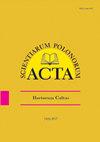THE IMPACT OF OPEN-FIELD AND PROTECTED CULTIVATION ON BIOCHEMICAL CHARACTERISTICS OF BANANAS (Musa spp. AAA)
IF 0.7
4区 农林科学
Q4 HORTICULTURE
Acta Scientiarum Polonorum Hortorum Cultus
Pub Date : 2022-06-30
DOI:10.24326/10.24326/asphc.2022.3.2
引用次数: 0
Abstract
Bananas have been grown in both open-field and protected cultivation in the subtropics. There are a very limited number of publications focusing on the impact of cultivation systems on the physico-chemical characteristics of bananas. For this reason, we assessed these fruit characteristics including sugars, malic acid, L-ascorbic acid, macro and micro nutrients well as fat and fatty acids of green and ripe bananas (Musa spp. AAA) in both cultivation systems. Experimental results have showed that many parameters affected the fruit ripening stage more than the cultivation system. Sucrose was the most abundant sugar followed by fructose and glucose in both the unripe and the ripe fruit stages. Sugar content, malic acid and L-ascorbic acid were higher in the ripe stage compared to the green stage. The cultivation system affected only glucose content, however, malic acid and L-ascorbic acid were not affected by the cultivation system. The most abundant macro and micro elements found were potassium and iron respectively. Cultivation system affected only potassium, zinc and manganese contents. Nitrogen and phosphorous, were found to be higher in the ripe stage. However, calcium, zinc, manganese and cupper were higher in the unripe stage. The fatty acid showed low value in the unripe stage for both cultivation systems. The concentration of MUFAs were found to be higher in the unripe stage for open-field condition while SFAs and PUFAs percentage were found to be higher in both cultivation systems. Experimental results clearly showed that physico-chemical characteristics of bananas were mainly affected by the ripening stage while the cultivation systems only affected a few characteristics.露天栽培与保护地栽培对香蕉生化特性的影响
香蕉在亚热带的开阔地和保护性栽培中都有种植。关注种植系统对香蕉物理化学特性影响的出版物数量非常有限。因此,我们评估了绿色和成熟香蕉(Musa spp.AAA)在两种栽培系统中的这些果实特性,包括糖、苹果酸、L-抗坏血酸、宏观和微观营养素以及脂肪和脂肪酸。实验结果表明,许多参数对果实成熟期的影响大于栽培制度。在未成熟和成熟果实阶段,蔗糖是最丰富的糖,其次是果糖和葡萄糖。成熟期的糖含量、苹果酸和L-抗坏血酸均高于青熟期。培养体系只影响葡萄糖含量,而苹果酸和L-抗坏血酸不受培养体系的影响。发现的最丰富的宏观和微观元素分别是钾和铁。栽培制度只影响钾、锌和锰的含量。氮和磷在成熟期含量较高。而钙、锌、锰和铜在未成熟期含量较高。脂肪酸在两种栽培系统的未成熟阶段都显示出低值。在露地条件下,MUFA的浓度在未成熟阶段较高,而SFAs和PUFA的百分比在两种栽培系统中都较高。实验结果表明,香蕉的理化特性主要受成熟期的影响,而栽培制度只影响少数特性。
本文章由计算机程序翻译,如有差异,请以英文原文为准。
求助全文
约1分钟内获得全文
求助全文
来源期刊
CiteScore
1.30
自引率
14.30%
发文量
61
审稿时长
4-8 weeks
期刊介绍:
In Acta Scientiarum Polonorum Hortorum Cultus we publish original research papers and review articles containing new and significant information on broad aspects of horticulture and related disciplines. The papers are published in English only, in six issues yearly.

 求助内容:
求助内容: 应助结果提醒方式:
应助结果提醒方式:


